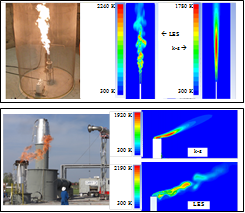Combustion Efficiency and Emissions of Industrial Flares

Project PI
Dr. Xianchang Li, Professor, Department of Mechanical Engineering
Full Description
Flaring is widely used in industries to dispose unwanted vent gases by burning them. Flare emissions account for 60% of the highly reactive volatile organic compound (HRVOCs). Collaborating with other professors, multiple projects have been done to lower the emissions from flare operations while maintaining the combustion efficiency required. For example, steam assist is commonly adopted to suppress smoking or black carbon emission. However, too much steam can lower the flare combustion efficiency and thus release more HRVOCs. Therefore, it is desired to minimize both the VOCs and black carbon emissions at the same time. Since the experimental data are limited, numerical study can provide in-depth understanding of industrial flares and make the operation optimization more feasible.
In this research, the details of chemical reaction need to be simulated together with the interaction with turbulence. Up to 50 species and hundreds of reactions are considered, which are subject to the limit of the software in use, ANSYS Fluent. So far flares with various combinations of models and parameters have been studied. For example, both non-premixed PDF (probability density function) and EDC (eddy-dissipation concept) models are applied while each model has its own advantage. The figure below presents the numerical results of temperature contours for one lab test and one field study by using both k-e and LES (large eddy simulation) models. It is observed that LES can mimic the flow pattern of the flares more closely. The current effort is to develop a better model for soot yields by exploring the interaction between soot and turbulence models as well as chemical reactions.